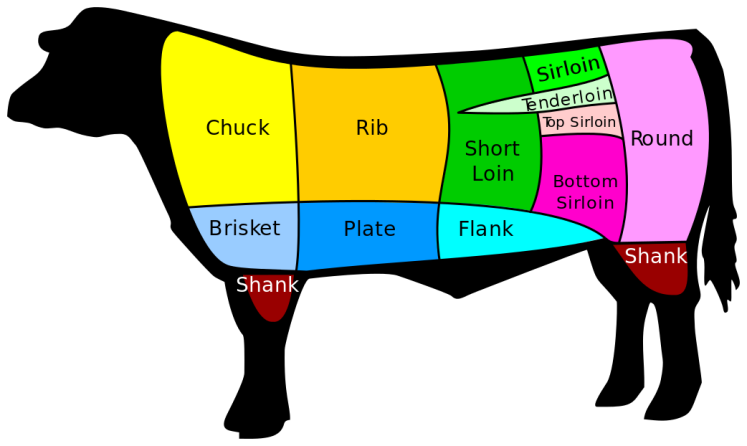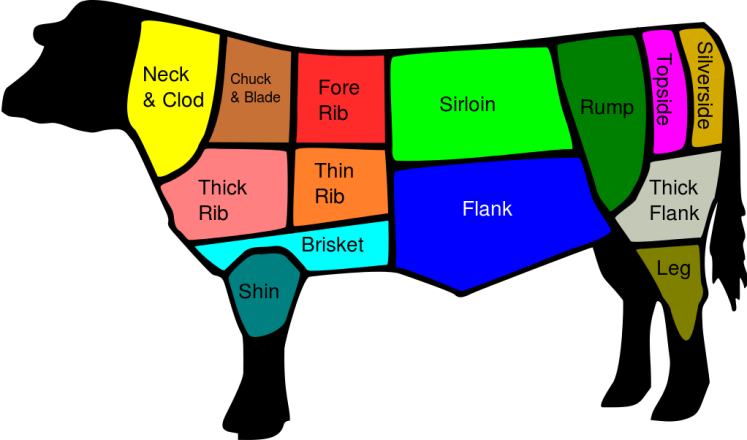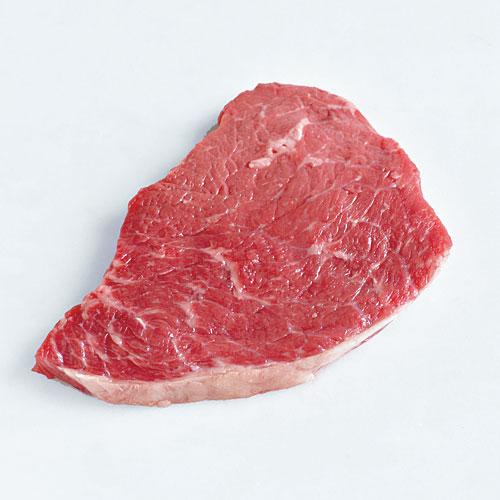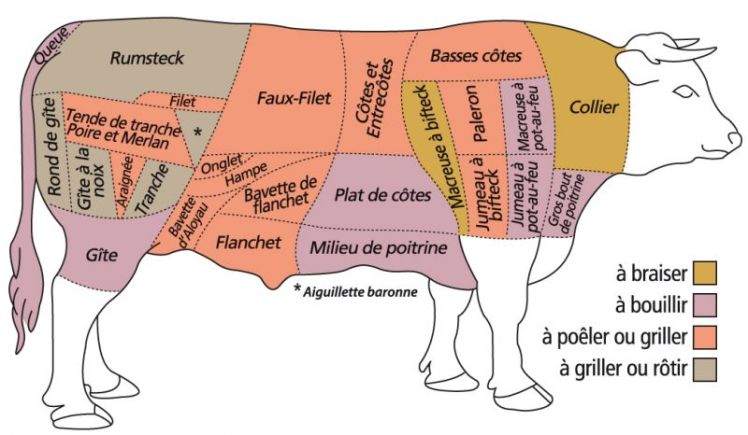I love meat. I have a passion for quality meat. There’s usually a story behind the steak you buy from a good traditional butcher: an animal that had a name, the way it was fed, the way it was bred, and was slaughtered.
I believe that the best breeders and butchers achieve best results when respect for the animals if the foundation around which they designed their production system.
As a Frenchman, I was very surprised to see that a lot of traditional cuts in France are not known or totally ignored in the US or in the UK and Ireland. So before I hope to introduce you to unsual cuts, let’s talk about what you usually find at your favorite butcher shop.
If you live in the US, most of the cuts you will find in the shops are those:

In the UK, it will probably look like that:

Why is it important to know which cut you are buying ?
Because the most expensive cuts are not the tastiest, and you can get amazing pieces of meat for a fraction of the price of the most expensive cuts. So it is worth it to spend some time trying and tasting different cuts.
Some cuts are more suitable for grilling, some more for slow-cooking. Knowing which cuts is for what use, will let you create delicious dishes at a very reasonable price.
Here’s a sample of common cuts that I find in Butcher shops in Ireland and generally speaking, anglo-saxon countries. I will post on a regular basis some recipes for each cut in the Recipes section, so check it out too !
The Housekeeper cut
Usually comes from the shoulder of the animal, like here:

Or from the neck, like here:

This is great slow-roasted (after searing it on a hot pan). It’s a really good value cut if you have several people to feed, hence the name). Make sure you make it rest a good 20″ before serving, you can leave it in the oven at low temp (60°C), so that it stays juicy.
The Round Steak
I would say that most of the steaks you find under the name “minute steak” come from this cut. A lot of the mince you buy, also comes from this cut.

It’s an easy cut, not the most tender, not the most flavourful, but if you are at a good butcher shop, you will get good value for your money. The best way to cook it in on a barbecue or a pan. I wouldn’t cook it more than medium rare as it get tough quickly.
The Tenderloin or Fillet Steak

Supposedly the king of cuts for a lot of people, it certainly is the most expensive in butcher shops. It’s certainly a nice and tender cut, grilled or cooked in the oven as Beef Wellington, but for me not the most flavourful. At this price, I definitely prefer to buy more Ribeye or other cuts and get more value for my money. It’s also quite a lean cut, so it’s best to cook it not over medium rare too.
The Striploin

It makes sense to talk about the Striploin after the Tenderloin as they are 2 cuts that you usually see together on a T-Bone Steak:

You can see the round shaped Tenderloin, and on the other side, the Striploin.
It’s a nice cut, but usually quite expensive, and to me, it’s less juicy and flavourful than the Ribeye. Best grilled on a pan or barbecue.
The Ribeye

Without a doubt one of the tastiest cuts you can get. It won’t be as expensive as the Tenderloin, and if cooked properly, will be juicer and more flavourful. The presence of fat around it and inside the muscular fibers (more or less marbled according to the breed and origin/feeding of the animal), keeps it moist during the cooking process, as well as giving it wonderful flavours. Best grilled on a barbecue. One of my favorite cuts.
The Sirloin

This cut has a particular history. There is a note upon this subject in the Athenian Mercury, March 6, 1694:
“King Henry VIII, dining with the Abbot of Redding, and feeding heartily on a Loyn of Beef, as it was then called, the Abbot told the King he would give a thousand marks for such a Stomack, which the King procured for him by keeping him shut in the Tower, got his thousand marks, and knighted the Beef for its good behaviour.”
The story of the Abbot of Reading and Henry VIII is taken from Fuller’s Church History of Britain, 1655, where Fuller uses the expression “a Sir-loyne of beef, so knighted, saith tradition, by this King Henry.”
Very close to the Tenderloin on the animal, this is probably the second most expensive cut. It’s usually tender and flavourful. So if your wallet don’t mind too much, go for it !
Now, let’s have a look at what you would typically find in a butcher shop in France.

As you can see, where you get 13-14 cuts in most Anglo-saxon countries, you have more around 30 in France.
Some of them are real treasures but not all butchers will have them.
Here’s a few of my favorites cuts.